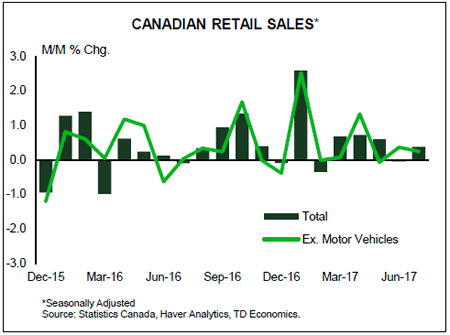U.S. Highlights
- Global stock markets this week rose to new highs in a number of regions, shrugging off elevated geopolitical tensions and the threat of a massive shake-up in global supply chains for the umpteenth week in a row.
- Retail sales rebounded strongly in September, helped by Hurricane-related rebuilding efforts. Looking ahead, we anticipate that consumer spending should pick up to a 3% annualized pace in the fourth quarter.
- Core consumer price growth disappointed in September, holding steady at a 1.7% y/y pace. Core measures of inflation have remained below target for much of the recovery even though economic slack has largely diminished. Persistently weak inflation makes us a little less certain about a December rate hike by the Fed.
Canadian Highlights
- It was a relatively quiet week in Canadian markets, with the loonie, oil, and equities all trading up as of late Friday morning.
- On the data front, it was all about housing. Led by a dip in Toronto, starts slowed slightly in September after two months of strong activity. On the other side of the coin, resale activity ticked up for a second month in a row, on broad cross-country strength.
- The near-term stabilization of housing activity is welcome after this summer’s readjustment in the important GTA market. However, we are not out of the woods yet, with a number of factors, including rising rates and regulatory changes likely to generate further medium-term headwinds.
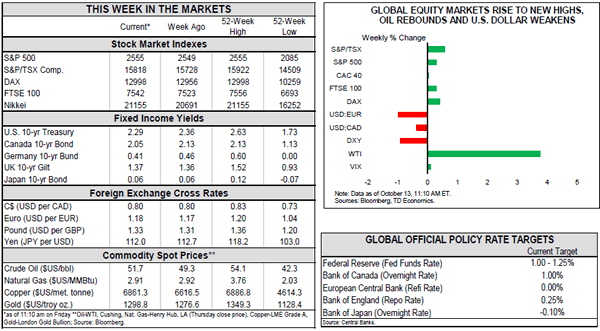
U.S. – Hurricane Recovery Efforts Bolster Consumer Spending
Global stock markets this week rose to new highs in a number of regions, shrugging off elevated geopolitical tensions and the threat of a massive shake-up in global supply chains for the umpteenth week in a row. It seems that nothing can derail the slow melt-up; not gradually rising interest rates, North Korean tensions, populist movements in Europe, or policy uncertainty emanating from the U.S. administration. Perhaps with low interest rates stimulating investor risk appetite this should be expected, but one can’t help but wonder what may happen to asset prices as global interest rates rise further off extraordinary low levels.
To some extent, rising asset prices fairly represent the state of the U.S. and global economy. Economic indicators for the third quarter continue to show a Hurricane-battered but resilient U.S. economy. This morning’s retail sales report for September recorded a 1.6% increase on the month, lifted by strong auto sales (18.5 million units), and building and material supply sales (Chart 1). Although the strength in these two categories likely reflected rebuilding efforts after Hurricanes Harvey and Irma, strong growth in other spending categories provides some underlying support to U.S. consumer spending heading into the fourth quarter. All told, we anticipate that rising incomes and strong job growth are supportive of a strong handoff to fourth quarter spending, with consumption expected to accelerate to a 3% annualized pace from 2% in the third quarter.
But, not all news on the U.S. economy was positive this week. The inflation report for September was disappointing. Headline inflation ticked up to a 2.2% y/y pace from a 1.9% pace in August, bolstered again by the Hurricane-related increase in gasoline prices that is expected to reverse in the months ahead. Most disappointing was core inflation, a measure that strips out volatile food and energy prices, which held at 1.7% y/y despite an expectation for a small uptick to 1.8%, with month-on-month prices rising a meagre 0.1% (or 1.2% annualized) rate.
This latest in a string of disappointing inflation readings will surely add fuel to the ongoing inflation puzzle debate going on in the Federal Reserve as evidenced by the minutes from its September meeting released this week. Core measures of inflation, including the Fed’s preferred core PCE deflator metric, have held below the 2% target for much of the recovery from the Great Recession even though economic slack has largely diminished (Chart 2). Fed officials remain somewhat divided on the topic. Some Committee members favor maintaining a highly accommodative monetary policy environment until wages and inflation show a persistent move higher, while others attribute much of the weakness to more temporary forces that do not warrant a pause in interest rate normalization. All told, we continue to anticipate that the Fed will raise rates this December, but the ongoing weakness in inflation makes us a little less certain about this call.
Taken together, above-trend economic growth in the U.S. and other regions are helping support asset prices. However, as the IMF pointed out this week, risks to the global economic recovery remain skewed to the downside. An unforeseen shock can easily derail the recovery, sending risk asset prices down with it.

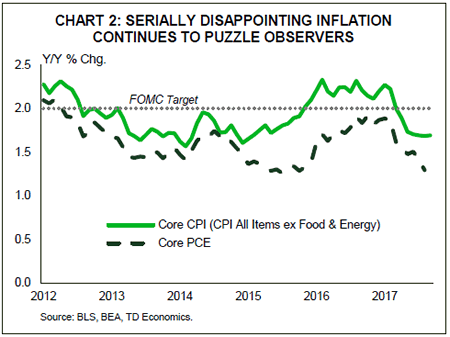
Canada – Housing Steadies, For Now
The shortened week was fairly light on the data front, with the releases focused on Canadian housing markets. Starting with new housing activity, September saw a modest pullback in housing starts, to 217k units. This was above market expectations, and comes on the back of two months of solid activity (Chart 1). The slowdown, such as it was, can be put down to Ontario, and the closely-watched Toronto market in particular, which saw a 18k drop in starts. Even with this softness, the third quarter saw Ontario starts at their second highest point in five years – the high point being the red hot pace recorded in the first quarter of the year.
In contrast to the starts data, the resale housing market saw a further tick-up in activity in September, with home sales up 2.1% month-on-month (Chart 2). It was a generally encouraging report, with healthy activity reported across the country. To focus on Toronto again, activity continued to rebound, but remains a far cry from the frenzy seen early in the year, and the sales-to-listings ratio, at 46%, suggests a relatively balanced market – a far cry from its peak of 94% in January. For the time being at least, Canadian real estate activity looks to have regained its footing – a welcome change after the volatility of this past summer. That said, we are not out of the woods just yet as a number of signs suggest that a slowing of activity may be on the horizon.
First, it remains likely that the Bank of Canada will hike its policy interest rate again this fall, most likely in December. In the grand scheme of things, while not overly aggressive, the 75bp of hikes over the second half of the year will work to reduce affordability and moderate demand. Second, looking a bit further out, OSFI may extend recent "B20" regulations to cover all mortgage lending. What this means is that all borrowers will need to show their ability to service a mortgage at the Bank of Canada’s posted rate (generally about 2 percentage points higher than typically contracted mortgage rates). Currently this requirement only applies to those with low down payments and those who are taking out mortgages with terms of less than five years. The high level of the posted rate makes this change particularly impactful: a further 25bp increase in rates will have an impact, to be sure, but adding 200bp to the rate for approval purposes is likely to result in a more significant reduction of mortgage approval sizes, all else equal. And, while there remains a lot of uncertainty around the path of interest rates, OSFI has so far shown no signs of backing down on this change.
Finally, for housing starts there is the simple matter of market dynamics. That multi-unit construction is the bulk of housing activity in Canada means that to a large extent, housing starts reflect earlier market conditions – condo pre-sales typically occur well in advance of construction. This implies that any slowing in presale activity in Ontario over the late spring and summer’s adjustment period is not likely to make itself felt in starts activity (let alone measures of ongoing construction activity) for some time to come. On balance then, it seems likely that as we move into 2018, housing activity is likely to moderate.
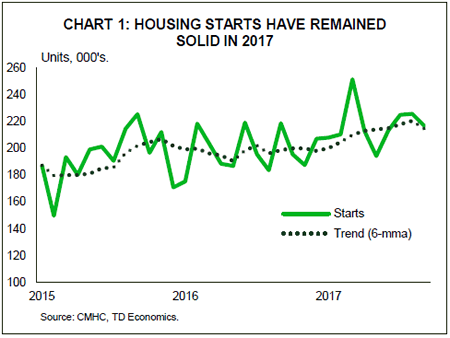
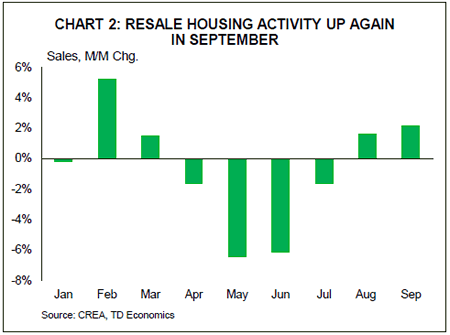
Canada: Upcoming Key Economic Releases
Canadian Manufacturing Sales – August
Release Date: October 18
Previous Result: -2.6% m/m
TD Forecast: -0.1% m/m
Consensus: NA
Manufacturing sales are expected to post their third consecutive decline in August, with nominal sales forecast to edge lower by 0.1% m/m. After a sharp decline in output caused by retooling shutdowns, factory shipments of motor vehicles should post a partial rebound in August. However, this report will not capture ongoing labour disputes, which will constrain any further recovery in September. Outside of the transportation sector, the weak export data and a broad decline in hours worked argue towards a downbeat report, though rising petroleum prices will help to support nominal refinery sales. Real manufacturing sales should underperform the nominal print due to higher factory prices.

Canadian Consumer Price Index – September
Release date: October 20
August Result: 0.1% m/m, 1.4% y/y
TD Forecast: 0.3% m/m, 1.7% y/y
Consensus: NA
TD looks for a 0.3% m/m increase in the September CPI, lifting the headline inflation rate to 1.7% y/y vs 1.4% y/y in August. Energy prices should be a net boost on higher gasoline prices, while food prices are at risk of downward pressures in light of the rapid appreciation seen in CAD. Other sources of downside include apparel – sensitive to currency fluctuations – along with telephone services, the latter which has plunged in the prior two months. On the upside, we expect to see continued strength in shelter prices from lagged effects from increases in the new housing price index. The fundamental story remains sound with labour market slack dissipating and wage pressures picking up, allowing core inflation measures to stabilize or firm further in this report. The Bank’s three measures averaged a 1.5% y/y pace in August; a move higher toward 2% would strengthen confidence that the output gap is approaching is closure, which we set estimate is by yearend.
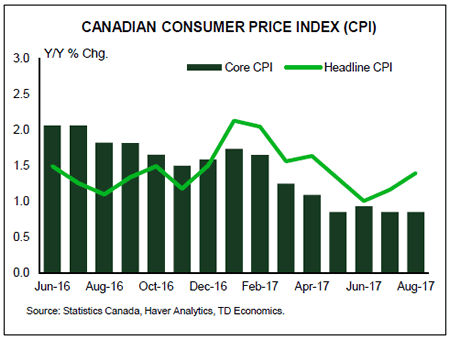
Canadian Retail Sales – August
Release Date: October 20
Previous Result: 0.4% m/m, ex-auto: 0.2% m/m
TD Forecast: 0.5%, ex-auto: 0.4% m/m
Consensus: NA
Retail sales are forecast to rise by 0.5% m/m in August, led by another increase in motor vehicle spending. This would leave ex-auto sales up 0.4% on the month, with gasoline station receipts expected to make a positive contribution due to Hurricane Harvey’s impact on prices. August saw the unemployment rate reach a post-crisis low while consumer confidence rose to record highs, both of which should support increased consumer spending. Core retail sales will also benefit from a recent pickup in wage growth, which has accelerated from early-2017 lows, though unseasonably cool weather may have a negative impact. Due to rising consumer prices, we look for real retail sales to underperform the nominal print with a more modest increase, consistent with a moderation in household spending growth from Q2.
